Biographical Notes reCharles A. (Chuck) StonePage 3 of 6 Pages, of Chapter 9,MOVING ON |
||||||||||||
| The irate phone calls began to come in. I was branded as the “killer” of the headquarters staff. There were previously concealed physical defects turning up right and left, threatening many who were still on flying status and drawing hazard pay. It became dangerous for me to walk through some of the hallways of the Pentagon. The first official action came when I received a call from the Office of the Chief of Staff that I would immediately notify all USAF addressees that from this day forward, personnel in the rank of Colonel and above would not have to comply with mandatory testing. It wasn’t long after that I was identified as the person responsible for plucking some of our combat ready crews out of the air, lowering the readiness rate of SAC units. I learned of a specific example where a B-52 crew at Blythville, Arkansas, had a delayed takeoff, and decided to use the time doing the 5 BX Program, together, on the ramp by the aircraft. I believe it was the Navigator who was young enough to be in the group that involved the use of the handclap push-up. As it was reported, he clapped and forgot to put his hands down, crashing his face (and possibly his glasses) into the concrete. The crew did not fly that day and it was my fault! It wasn’t long before the Headquarters Inspector General’s Office, Deputy Commander, called me and asked how the Headquarters fitness exams were coming along. I told him that I had just received a report from the Officer in Charge of the testing location at Bolling AFB and would be happy share the information with him. He asked me to come right down. Walking into his office, I saw before me a General Officer in superb physical condition. I handed him the report broken down by Headquarters USAF Departments. It didn’t surprise me to see him turn purple when he came to the compliance figures for his own Directorate. They were very poor. He regained his composure, thanked me for sharing the information, and retained his copy of the report, as I went on my way. A few days later, the underground communication system got word to me that he had really taken his entire staff to task for their noncompliance with the testing directive. The halls of the IG office became one of the more sensitive mine fields for me to tread. The word Viet Nam was spoken more and more in the Headquarters. There was a glimmer of growing interest in the relationship between USAF personnel and proficiency with small arms. I found myself increasingly working to upgrade the language in the variety of regulations that outlined Air Force training and munitions procurement and management procedures. Along with that, two issues moved to the front of the stage, hand in hand. They involved General LeMay’s love affair with the new AR-15 Armalite Rifle, later designated the M-16. The other had to do with the potential for use of pellet gun simulators in small arms training. |
||||||||||||
| The Crossman and Technicolor folks had been busy putting form and function on my ideas for both the 357 magnum pistol and the multi-use pellet trap. I had recently traveled to the Crossman Company, at Rochester, NY, to check out their progress. We agreed on a few refinements and they soon shipped me a box of the revolver simulators and two sample pellet trap systems. The larger trap was on wheels, permitting it to be moved from place to place with ease. My boss, Fred Howard, the shooter, was most excited and quickly demonstrated our proposed equipment and concepts to his immediate supervisors. We agreed that we would begin a steppingstone series of briefings and demonstrations that we hoped, eventually, would lead to General LeMay’s office. We knew this would take time and effort to work through the coordination maze. The following morning Colonel Morganti, Fred’s boss, came in and asked if we could get ready to brief the Chief of Staff, General LeMay, and his Deputy, General McConnell, later in the morning. Word traveled fast, sometimes. We said we would be ready. Soon, Colonel Morganti, Lt. Col. Howard and I were wheeling our stuff down through the Pentagon halls, enroute to the head shed. What a break. We were ushered into a hall-like room that was between the two Chief of Staff offices. It made an ideal layout for an indoor shooting range. In a matter of moments, really before we could make any kind of a formal pitch, both Generals came bounding into the room, picked up the pistols and began shooting at every kind of target we could show them. These included NRA, Olympic and moving targets on a pull-down screen. They pretended to be Combat Support troops on the flight line, trying to shoot the saboteur without blowing out a tire on a B-52, they were combat crews down in enemy territory, escaping and evading, and shooting at balloons and other targets that moved across the screen at varying speeds. General LeMay exclaimed “From now on we won’t just teach them how to shoot, we will teach them when to shoot.” Every now and then General LeMay’s office door would open and his Exec would attempt to remind him of people waiting to meet with him. General LeMay thanked him, shoved the door shut and kept on shooting. When they were both satisfied, General LeMay turned to all of his presenters and said “I want this program established at every base in the United States Air Force as soon as possible.” We picked up our marbles and headed for our office, flushed with victory. In an effort to speed compliance with General LeMay’s directive, Fred and I drafted out a letter for his personal signature that put him on record with all of his commanders as to what he really said. We didn’t get that letter past Fred’s boss. Probably with good intentions, but we could see this ghost of marksmanship resistance rise again before us, we were told to just proceed and use normal channels to get on with the program without creating a stir. Well, you can be sure that a lot of the fizz charge went out of our Champaign with that instruction. It set the full implementation of our program back by a couple of years. We were encouraged when the FBI got in touch with us and familiarized themselves with what we were doing. I am not sure what became of it, but I did hear they were speeding up steps to get moving target shooting more involved in their training. These events certainly got sufficient attention to our project so that doors were opening that had been hard for us to get through, previously. Talk of shooting simulators raised the hackles of some of the died-in-the-wool gun enthusiasts. They were immediately fearful that this would diminish the pressure for use of the real thing in training. Although hard to pinpoint, we did have to deal with resistance from those with this point of view. Whatever, this program was moving forward, not backward. |
||||||||||||
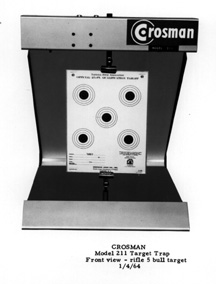 |
||||||||||||
|
|
||||||||||||
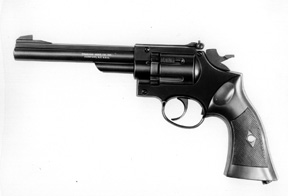 |
||||||||||||
|
Revolver Simulator. This pellet revolver was designed and built to be of the same weight, balance and functional feel of the 357 Mag. Revolver. |
||||||||||||
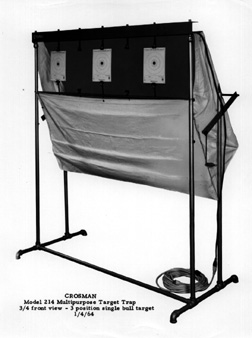 |
||||||||||||
|
set up for 3 position single bull targets. |
||||||||||||
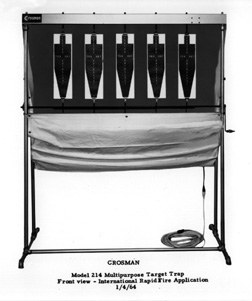 |
||||||||||||
|
set up for International Rapid Fire Application |
||||||||||||
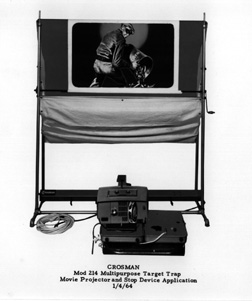 |
||||||||||||
|
set up with Movie Projector and Stop Device Application |
||||||||||||
|
End of Page 3 of 6 Pages, Chapter 9 — Go to Page 4 Click below to select a destination Go to Page 1 — 2 — 3 — 4 — 5 — 6, this Chapter Chapters 1 — 2 — 3 — 4 — 5 — 6 — 7 — 8 — 9 — 10 |
||||||||||||